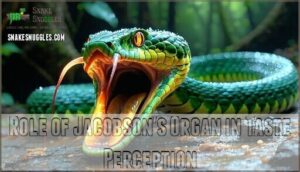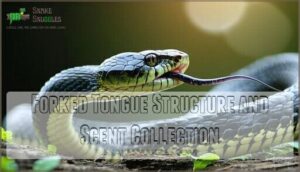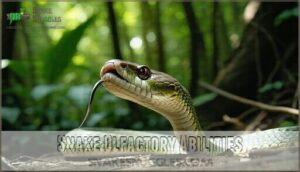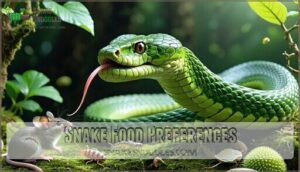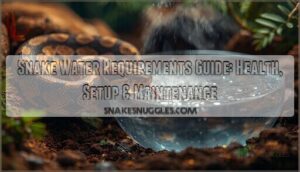This site is supported by our readers. We may earn a commission, at no cost to you, if you purchase through links.
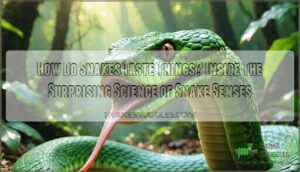
Instead, when you watch a snake flick its forked tongue, it’s collecting chemical molecules from the air. These molecules travel to a special organ called the Jacobson’s organ, located in the roof of their mouth.
This organ works like a chemical detector, letting snakes "taste" their environment. They also have regular taste buds on their mouth’s roof for when they’re actually eating.
This dual system helps them hunt prey and avoid danger. The forked tongue design even lets them determine which direction scents come from.
Table Of Contents
- Key Takeaways
- How Do Snakes Taste Things?
- Snake Taste Mechanism
- Snake Tongue Function
- Snake Olfactory Abilities
- Snake Food Preferences
- Snake Tongue and Nostril Function
- Snake Sensory Perception
- Frequently Asked Questions (FAQs)
- How do snakes taste their food?
- What body part do snakes use to taste the air?
- How do snakes eat their food?
- Why does a snake’s tongue get out?
- How do snakes taste without taste buds?
- Do snakes have a good sense of taste?
- How do snakes smell?
- Can snakes taste with their tongues?
- What is the Jacobsons organ?
- Can snakes taste sweet or bitter flavors?
- Conclusion
Key Takeaways
- You’ll discover snakes don’t taste with their tongues like you might think – instead, they use their forked tongues to collect chemical molecules from the air and ground, then transfer these particles to a special organ called Jacobson’s organ in the roof of their mouth for processing.
- You’re watching a sophisticated chemical detection system when snakes flick their tongues – this isn’t random behavior but rather precision sampling that lets them "taste" their environment, hunt prey, avoid predators, and navigate safely through chemical analysis.
- You’ll find snakes have limited traditional taste buds compared to humans – they rely on specialized receptors and their vomeronasal organ to detect chemical cues, creating a unique blend of taste and smell that’s completely different from how you experience flavor.
- You can think of snake sensing as "stereo smelling" – their forked tongue design allows each tip to collect different chemical gradients simultaneously, giving them directional scent information that works like a built-in GPS for tracking prey and mapping their surroundings.
How Do Snakes Taste Things?
Snake taste is nothing like what you experience.
Without traditional taste buds—what scientists call Taste Bud Absence—snakes depend on Chemical Cue Detection.
When a snake flicks its tongue, it’s not tasting the air but collecting particles.
These go straight to Jacobson’s organ, creating a Tongue-Jacobson Synergy.
This teamwork lets snakes analyze prey chemicals and sense their environment.
Taste buds called papillae are scattered throughout the oral cavity.
Snake taste perception is a blend of smell and taste, called snake chemoreception, helping them with Environmental Taste Sensing and Prey Chemical Analysis.
Snake Taste Mechanism
You might think snakes taste things like humans, but their taste system works very differently.
Instead of using taste buds, snakes rely on special receptors and a unique organ in their mouths to detect chemical cues from their environment, using a system that is based on special receptors.
Role of Jacobson’s Organ in Taste Perception
Right up on the roof of the mouth, Jacobson’s organ acts like a secret lab for Chemical Analysis.
When your snake flicks its tongue, it gathers Environmental Cues and delivers them straight to this organ.
Here, Sensory Input is decoded, helping with Prey Detection and mate recognition.
The vomeronasal organ, or Jacobsons organ, is key to snake chemoreception—turning faint scents into clear signals for survival. It also contains specialized receptor cells called esthesiocytes.
Vomeronasal Organs and Chemical Detection
When you explore how snakes sense their world, the vomeronasal organ (VNO) stands out.
It’s like their own built-in chemical lab, tucked inside the roof of the mouth.
This organ, also called Jacobson’s organ, helps process chemical signals and gives snakes a unique edge in taste and smell.
Here’s how it works:
- Chemical signal processing: The snake tongue flicks out, grabs scent particles, and delivers them to the VNO sensory cells.
- Prey chemical cues: Snakes pick up faint traces of prey, helping them hunt even in the dark.
- Mate detection: The vomeronasal organ helps spot potential mates by reading chemical signals.
- Environmental analysis: It lets snakes analyze their surroundings for safety and food.
Snakes also experience sensory limitations due to a lack of external ears.
Snake Tongue Function
When you watch a snake flick its tongue, you’re seeing a special way it gathers chemical particles from the air and ground.
This forked tongue lets the snake collect detailed information about its surroundings, which is important for finding food and staying safe.
Importance of Tongue Flicking Behavior
When you think about snake senses, it’s easy to imagine sharp eyes or quick reflexes. But the real magic happens with their tongue flicking. Each flick isn’t just for show—it’s a high-tech tool for Environmental Sampling.
The snake tongue gathers tiny chemical clues, which the vomeronasal organ (Jacobson’s organ) then uses for Chemical Analysis. This process gives snakes Sensory Input needed for Prey Detection and Navigation Aid. It’s like reading invisible messages in the air and on the ground.
Snakes use their tongues to engage in environmental scent deciphering.
| Action | What It Does | Why It Matters |
|---|---|---|
| Tongue Flicking | Collects molecules | Finds prey, mates |
| Vortex Creation | Traps particles | Improves detection |
| Jacobson’s Organ | Analyzes chemicals | Decides what’s food |
| Flick Patterns | Samples environment | Tracks prey, avoids danger |
| Sensory Input | Guides movement | Navigates surroundings |
Forked Tongue Structure and Scent Collection
A snake’s forked tongue is like nature’s split-end detector, built for high-precision air molecule collection.
Here’s how your snake’s tongue bifurcation works:
- Dual Sampling: Each fork moves independently, collecting chemical signals from two directions at once—think of it as stereo smelling.
- Environmental Sampling: The forked tongue sweeps the air, picking up scent particles and transferring them for chemoreceptor activation in the vomeronasal organ.
- Scent Particle Transfer: After each flick, the tongue delivers these particles to the Jacobson’s organ, helping the snake pinpoint prey, sense mates, and navigate its world.
Snake Olfactory Abilities
You’ll notice that snakes rely on their sense of smell to find food and understand their surroundings.
Their olfactory abilities are highly developed, letting them detect faint chemical cues for hunting, avoiding danger, and choosing mates.
Stereo Smelling and Environment Navigation
With their forked tongue, snakes use stereo smelling to map their world in 3D.
Each tongue tip picks up different chemical gradients, sending separate signals to the vomeronasal organ.
This sensory integration lets you pinpoint prey location, navigate obstacles, and track mates by following environmental cues.
The snake tongue function is like having a built-in GPS for scent.
Through 3D olfaction, you can sense subtle changes in your environment, making snake smelling a powerful tool for survival and exploration.
The Relationship Between Smell and Taste in Snakes
In the context of how you sense the world if you were a snake, smell and taste work together like two sides of the same coin.
You won’t find many taste buds in a snake’s mouth, but their snake olfactory system is sharp.
The vomeronasal organ, or Jacobson’s Organ, sits on the roof of the mouth and reads chemical cues collected by the forked tongue.
This Sensory Integration helps with Chemical Communication, Prey Detection, and interpreting Environmental Cues.
Snakes rely on these abilities for survival, using Evolutionary Adaptation to make up for their limited traditional taste.
Their papillae, or oral cavity taste buds, are key to detecting chemical signals.
So, snake taste and snake smelling are deeply connected, with the Jacobsons Organ leading the way in their sensory world.
Snake Food Preferences
You’ll discover that snakes don’t choose their food based on taste like you do, but instead rely on scent to decide what’s worth eating.
When a snake flicks its tongue near potential prey, it’s collecting chemical information that tells it whether the meal will be nutritious and easy to catch.
Factors Influencing Food Preferences
Several key elements shape your snake’s dietary choices beyond simple snake taste preferences.
Understanding these factors helps explain snake feeding preferences and dietary habits:
- Prey Availability – Local ecosystem composition directly determines what food sources your snake encounters and considers suitable meals.
- Scent Familiarity – Previous feeding experiences create learned preferences, with snakes favoring foods that smell similar to successful past meals.
- Nutritional Value – Environmental factors influence how snakes assess energy content and digestibility when selecting prey items.
Snakes often prefer chewy food options.
The Influence of Olfaction on Snake Behavior
Through their incredible olfactory abilities, you’ll discover that snakes navigate their world like living chemical detectors.
Their vomeronasal organ processes scent molecules to guide critical decisions about survival and reproduction.
Snake smell perception drives four main behavioral patterns:
| Behavior | Purpose |
|---|---|
| Hunting Strategies | Track prey trails and assess food quality |
| Mate Selection | Identify potential breeding partners |
| Predator Avoidance | Detect threats and escape routes |
| Habitat Choice | Locate suitable shelter and territory |
Scent Communication allows snakes to leave chemical messages for other snakes.
This snake olfactory perception system works constantly – every tongue flick samples the environment.
Unlike basic snake taste, their smell-based navigation system helps them read their surroundings like a detailed map, influencing every aspect of snake behavior from daily hunting to seasonal migrations.
Snake Tongue and Nostril Function
You’ve probably noticed how snakes constantly flick their forked tongues in and out, but this isn’t just a quirky habit.
While snakes do have nostrils, they rely much more on their tongues to collect chemical particles from the air and ground, which they then transfer to a special organ in their mouth for analysis, using this method for analysis.
Snake Tongue’s Role in Smelling
While snakes can’t taste like you do, their tongue flicking behavior creates something far more impressive.
You’ll notice snakes constantly dart their forked tongue out to sample the air and ground.
This isn’t random – it’s sophisticated scent collection in action.
Each fork gathers chemical analysis data from different spots simultaneously, then transfers these molecules to the vomeronasal organ on their mouth’s roof.
This system transforms their snake tongue into a powerful smell detector, enabling precise prey detection and navigation through snake olfactory perception.
The Function of Snake Nostrils in Smell Detection
Working alongside their famous forked tongues, your snake’s nostrils serve as the first line of chemical detection.
These specialized openings don’t just handle breathing—they’re sophisticated scent-gathering tools that capture airborne molecules before detailed tongue analysis begins.
Snake nostril structure includes specialized chemoreceptors that detect basic environmental cues through nares chemoreception.
Nostril airflow brings a constant stream of chemical particles into the snake nasal cavities, where initial scent molecule intake occurs.
This olfactory contribution works independently from the vomeronasal system, providing continuous environmental monitoring.
Here’s how snake nostrils enhance smell detection:
- Dual-purpose design – Handle both breathing and chemical detection simultaneously
- Continuous sampling – Provide constant airflow for ongoing scent analysis
- Initial alerts – Trigger tongue-flicking behavior when interesting odors appear
- Underwater detection – Special valves allow chemical sensing in aquatic environments
- Species adaptation – Structure varies based on habitat and hunting requirements
This nostril function complements tongue-based detection, creating a thorough chemical sensing system.
Snake Sensory Perception
You’ve learned how snakes use their tongues and nostrils to gather chemical information from their environment.
Now you’ll discover how these sensory systems work together to create a unique form of taste perception that’s completely different from how humans experience flavor.
Snake Oral Chemoreception and Taste
When you think about how snakes experience taste, you’re looking at nature’s clever workaround.
Unlike mammals with thousands of taste buds, snakes have few or no traditional tastebuds in their oral cavity.
Instead, their gustatory system relies heavily on oral chemoreception – a fancy term for tasting through chemical detection.
Here’s where it gets interesting: snakes don’t actually "taste" food the way you do.
Their taste receptor types are limited, focusing mainly on chemical cue analysis rather than sweet, salty, or sour flavors.
The oral cavity receptors work differently than yours, processing chemical information through specialized cells rather than conventional taste buds.
This chemoreception evolution makes perfect sense when you consider a snake’s lifestyle.
Their flavor perception limits don’t handicap them – they’ve simply developed a more sophisticated chemical detection system.
The snake tongue collects molecules, but the real magic happens when these chemicals reach specialized receptors in their mouth, creating their unique version of "taste.
Smell’s Influence on Snake Behavior
Their olfactory system drives every major decision.
You’ll find snakes using scent communication for mate selection and territory marking.
Their sensory perception guides hunting strategies – they track prey trails like bloodhounds.
Predator avoidance relies on detecting danger through chemical cues.
Habitat choice depends on analyzing environmental scents.
While snake taste exists, snake smell through their snake tongue controls behavior completely.
Frequently Asked Questions (FAQs)
How do snakes taste their food?
Like culinary detectives, you’ll find snakes don’t taste food traditionally.
They use forked tongues to collect chemical particles, then transfer them to Jacobson’s organ in their mouth for processing taste and smell information together.
What body part do snakes use to taste the air?
You’ll find that snakes use their forked tongues to taste the air.
They flick their tongues out to collect chemical particles, then transfer these molecules to their Jacobson’s organ for processing and analysis.
How do snakes eat their food?
Snakes swallow their prey whole without chewing. They unhinge their flexible jaws to accommodate large meals, using powerful muscles to push food down their throats into their stomachs for digestion.
Why does a snake’s tongue get out?
You’ll see a snake’s tongue flick out to collect chemical particles from the air and ground.
It’s their way of "tasting" and "smelling" their environment to find food, detect predators, and navigate safely.
How do snakes taste without taste buds?
Incredibly, your scaly friend doesn’t need taste buds to savor meals.
You’d be amazed how they use specialized receptors in their mouth and Jacobson’s organ to detect chemical cues, combining taste with smell for survival.
Do snakes have a good sense of taste?
Actually, snakes don’t have a great sense of taste like you do.
They’ve got limited taste buds but rely heavily on their incredible sense of smell through tongue-flicking to identify food.
How do snakes smell?
You’ll find snakes use their forked tongues to collect chemical particles from the air.
They transfer these molecules to their Jacobson’s organ, located in their mouth’s roof, which processes scent information.
Can snakes taste with their tongues?
Snakes don’t taste with their tongues like you might think.
Their forked tongues collect chemical particles from the air, then transfer them to Jacobson’s organ in their mouth for processing taste and smell information.
What is the Jacobsons organ?
Specialized sensory sleuth, the Jacobson’s organ sits on your snake’s mouth roof.
You’ll find this vomeronasal organ processes chemical particles that the forked tongue collects, basically letting snakes "taste-smell" their environment for hunting.
Can snakes taste sweet or bitter flavors?
Most snakes can’t taste sweet flavors like you do.
They’ve lost sweet taste receptors through evolution.
However, Burmese pythons retain some sweet taste function.
Bitter taste detection varies by species, but it’s generally limited compared to mammals.
Conclusion
Ever wondered why snakes flick their tongues so often?
Now you understand how snakes taste things through their remarkable dual sensory system.
Their forked tongues collect chemical molecules from the air, delivering them to the Jacobson’s organ for analysis.
This sophisticated mechanism allows snakes to detect prey, identify threats, and navigate their environment with incredible precision.
Combined with traditional taste buds, this system gives snakes a unique advantage in survival that’s truly fascinating to observe.

